Opticon Sensors Europe EE750R ESL Electronic Shelf Label User Manual EE 750 Electronics Shelf Label
Opticon Sensors Europe BV ESL Electronic Shelf Label EE 750 Electronics Shelf Label
Spec manual
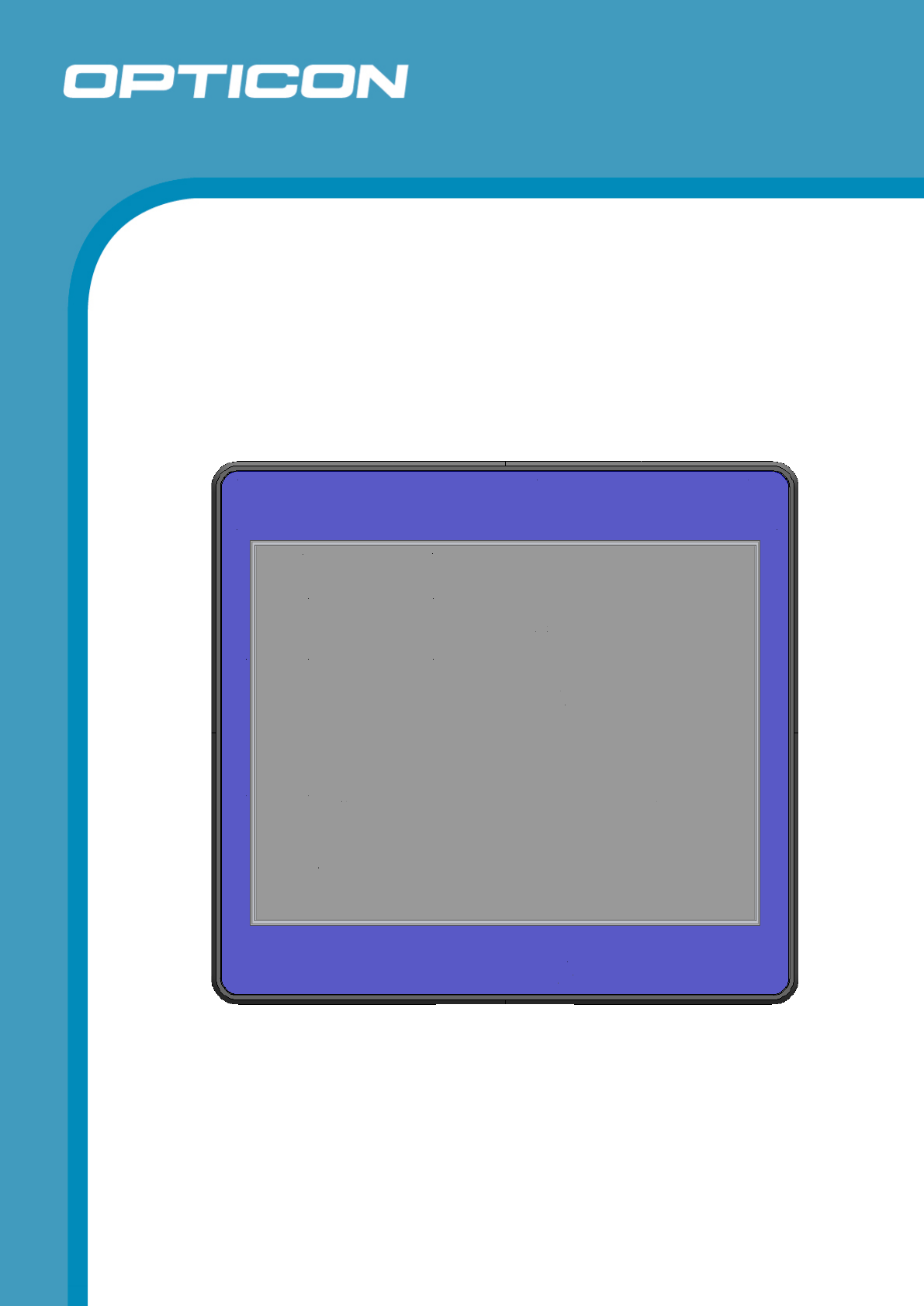
Electronic shelf label
EE-750R
EE-750R
The EE-750R is a black/white/red E-ink based
electronic shelf label with a screen size of 7.5” and
with 802.15.4 based wireless communication.
Specifications Manual

EE-750R
2
Document History
Model Number:
EE-750R
Specification Number:
Edition:
1.0
Original Spec Number:
Date:
April 7, 2017
Copyright 2017 Opticon Sensors Europe BV. All rights reserved.
Limited Warranty and Disclaimers
Serial Number
Warranty
Packaging
Trademarks
-
---------
SUPPORT
USA
Europe
Phone: 800-636-0090
Phone: +31235692728
Email: support@opticonusa.com
Email: support@opticon.com
Web: www.opticonusa.com
Web: www.opticon.com

-
3
Contents
1. Abstract ..................................................................................................................................... 5
2. Overview ................................................................................................................................... 5
3. Physical Features ..................................................................................................................... 6
3.1. Dimensions ....................................................................................................................... 6
3.2. Weight ............................................................................................................................... 6
4. Environmental Specifications .................................................................................................. 6
4.1. Operating Temperature and Humidity ................................................................................ 6
4.2. Storage Temperature and Humidity ................................................................................... 7
4.3. Static Electricity ................................................................................................................. 7
5. Controls ..................................................................................................................................... 7
6. Electrical Specifications ........................................................................................................... 7
6.1. Power and battery ............................................................................................................. 7
6.2. Radio Specifications .......................................................................................................... 8
6.3. Radio Protocol ................................................................................................................... 8
6.3.1. The physical layer ...................................................................................................................... 8
6.3.2. The medium access control layer .............................................................................................. 8
6.3.3. Security ...................................................................................................................................... 8
7. Labeling ..................................................................................................................................... 9
7.1. Product label ..................................................................................................................... 9
7.2. Shipment box label .......................................................................................................... 10
8. Accessories ............................................................................................................................ 11
9. Packaging Specifications ....................................................................................................... 11
10. Regulatory Compliance .......................................................................................................... 13
10.1. Product Safety ................................................................................................................. 13
10.2. EMC ................................................................................................................................ 13
10.3. WEEE.............................................................................................................................. 13
10.4. RoHS .............................................................................................................................. 14
11. Safety ....................................................................................................................................... 15
11.1. Shock .............................................................................................................................. 15
11.2. Temperature Conditions .................................................................................................. 15
11.3. Foreign Materials ............................................................................................................. 15
11.4. Battery ............................................................................................................................. 15
11.5. Disposal .......................................................................................................................... 15
11.6. Other ............................................................................................................................... 15
12. Mechanical Drawing ............................................................................................................... 16

-
4
Table of Figures
..................................................................................................................
................................................................................................................
.............................................................................................
.....................................................................................................
- ...................................................
........................
................
...................................................................................................

-
5
1. Abstract
This manual provides specifications for the EE-750R electronic shelf label (hereafter referred to
ESL
2. Overview
The EE-750R is an Electronics Shelf Label with a 2.4GHz radio for data communication. The
product has a 3-color E-ink based e-paper display with black, white and red pixels. This product
uses Direct Sequence Spread Spectrum RF technology that allows for an ultra-low power
consumption combined with a reduced sensitivity to background noise. That means less
interference by other radios that operate in the 2.4GHz band. The radio protocol that is used is
based on the IEEE 802.15.4 standard that specifies the physical layer and media access control
for low-rate wireless personal area networks. The protocol is entirely implemented, except for
some small changes that have all to do with the connection protocol to a base station. When the
base station is not available the EE-750R switches to a non-802.15.4 standard to lower the
power. That is especially meaningful when the EE-750R is not being used for a prolonged
period of time (e.g. during shipping)
The EE-750R is intended to be operated in combination with a base station such as the EBS-40
which can control a large number of EE-750R and other types of ESL of the same family such
as EE-202 and EE-420.
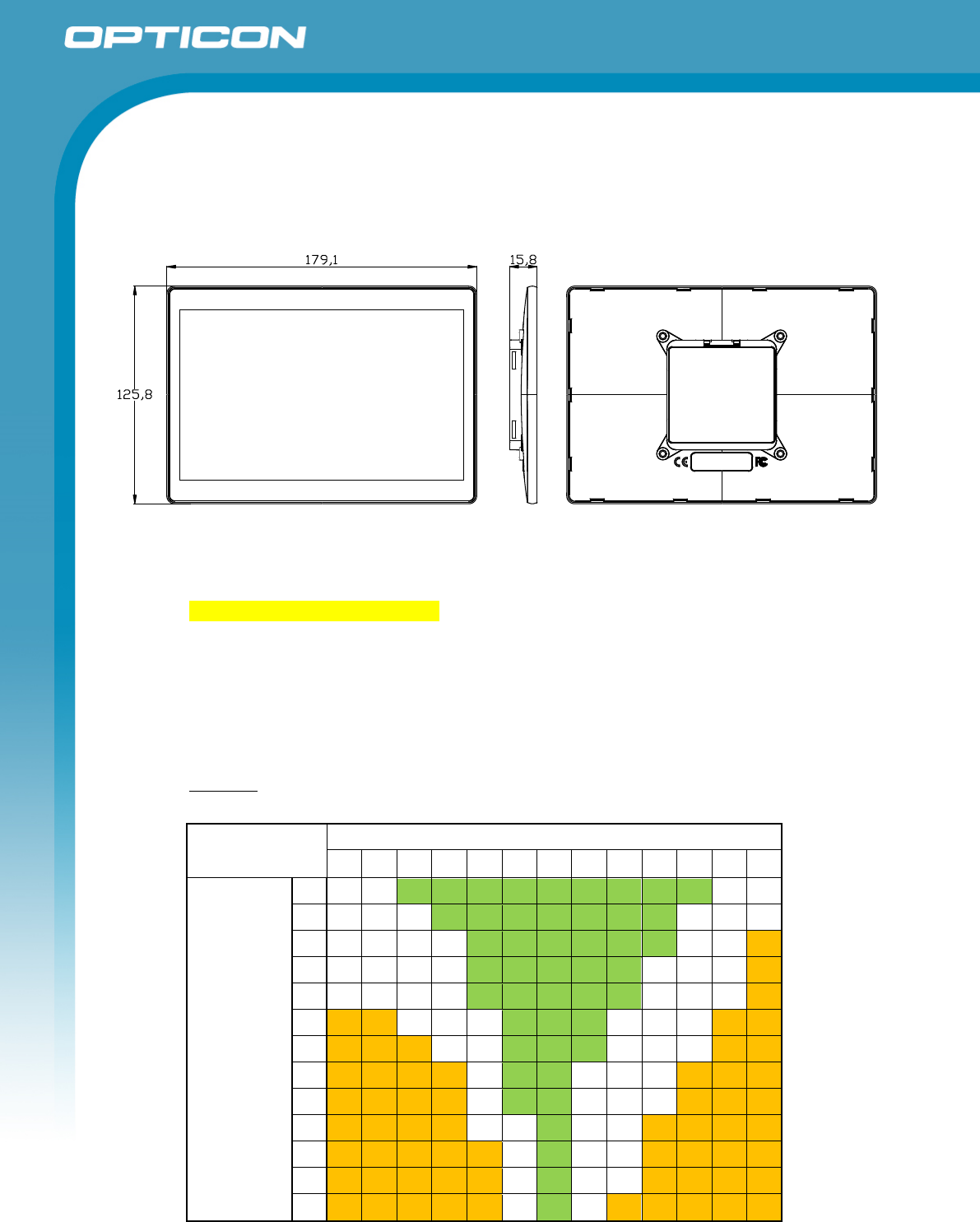
-
6
3. Physical Features
3.1. Dimensions
(WxHxD): 179.1 x 125.8 x 15.8 mm
3.2. Weight
150 g (including batteries) TBD
4. Environmental Specifications
4.1. Operating Temperature and Humidity
Temperature: 0 to 40° C
Humidity: 30% to 70% RH
Warning: Make sure to use the EE-750R under the recommended (green) combinations
of temperature and humidity and never use it under the orange marked conditions.
Recommended
temp./humidity
Relative Humidity (%)
20
25
30
35
40
45
50
55
60
65
70
75
80
Temp.
0
5
10
15
20
25
30
35
40
45
50
55
60
Figure 1: Dimensions
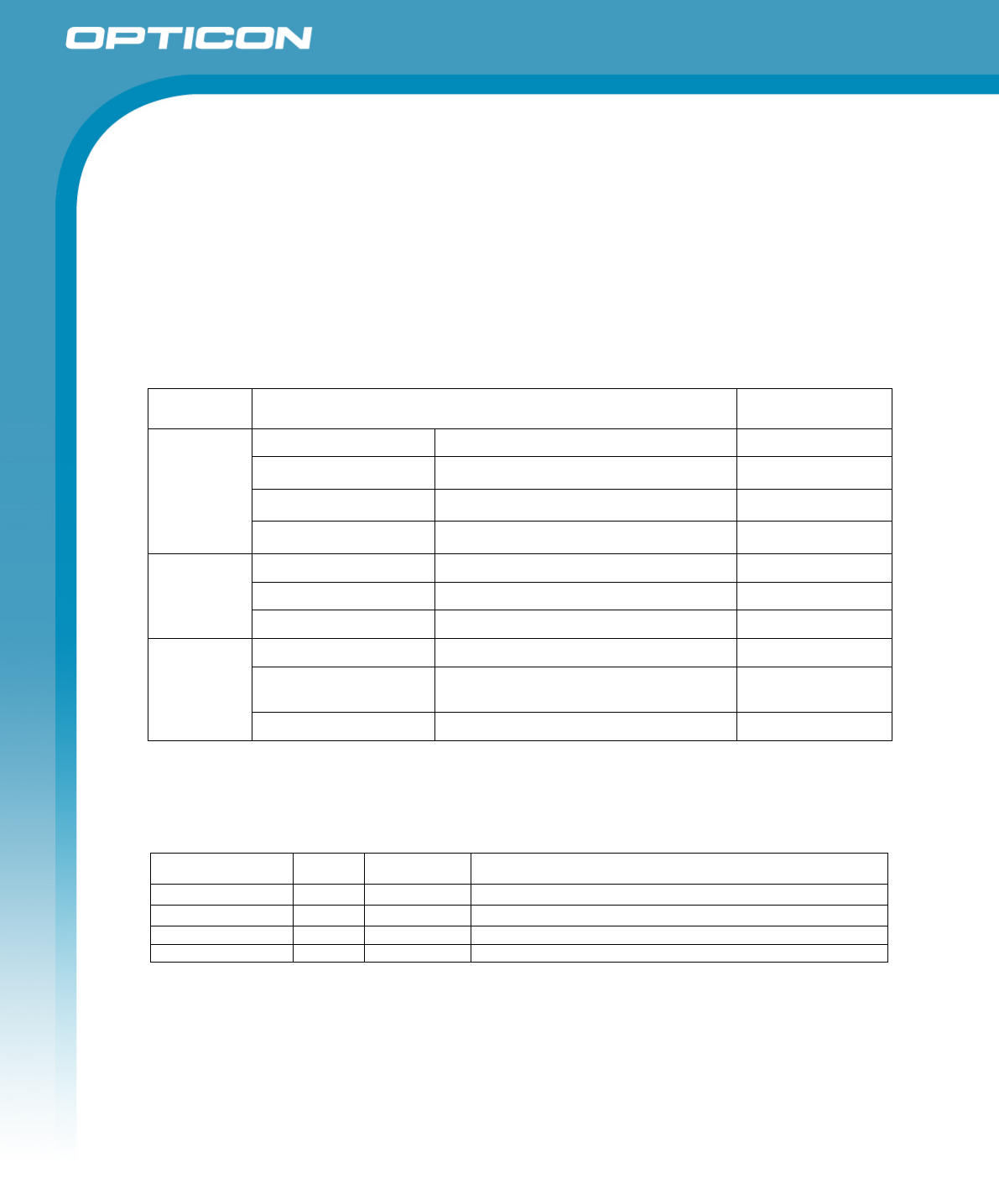
-
7
4.2. Storage Temperature and Humidity
Temperature: -20 to 40° C
Humidity: 30% to 70% RH
4.3. Static Electricity
Air discharge:
± 8 kV MAX (No malfunction)
Contact discharge:
± 4 kV MAX (No malfunction)
5. Controls
Items
Specifications
Remarks
CPU
Type
8-bit
ROM
256KB
RAM
8 KB
Clock frequency
32 MHz
LCD
Active area
W 84.8 x H 63.6 mm
Number of dots
W 400 x H 300
Dot pitch
0.21 x 0.21 (107dpi)
mm
Radio
Modulation
DSSS
Frequency
2405-2480 MHz
Globally approved
2.4GHz band.
Baud rate
250 Kbits / second
6. Electrical Specifications
6.1. Power and battery
Parameter
Typ
Unit
Remarks
Operating voltage
3.0
V
4x Alkaline AAA size battery
Battery life
5
Years
Reference: Panasonic LR03XWA 2 updates per day
Sleep current
<1
µA
When the transmitter and receiver are idle
Poll rate
>5
Per sec.
See below
The ESL is in sleep mode almost the entire time. The device wakes up at regular intervals
(called the poll time) and it then transmits a poll request to the base station. When the base
station has no data to send, it just acknowledges the poll after which the ESL immediately goes
back to sleep. The poll rate is configurable and is set to 20 seconds by default. A higher poll
rate will decrease the power consumption but will increase the response time.
The power is supplied to the EE-750R by four replaceable Alkaline AAA size batteries (not
included). The typical operation time on a set of batteries is 5 years when using quality alkaline
batteries, based on a poll rate of 20 and on average two display updates per day.
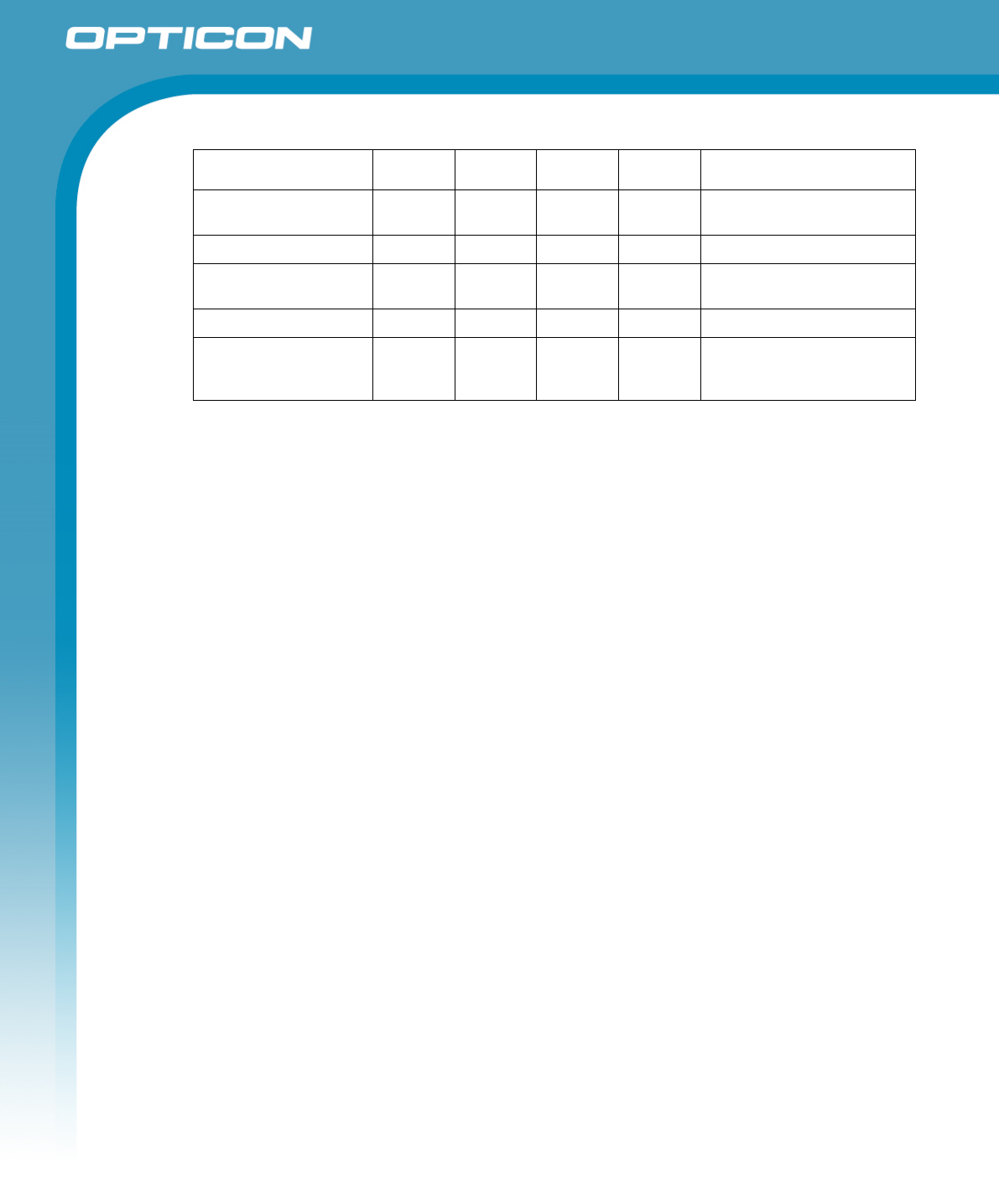
-
8
6.2. Radio Specifications
Parameter
Min
Typ
Max
Unit
Remarks
Receiver sensitivity
-97
-89
dBm
Over the entire temp. and
operating voltage range
Nominal output power
-3
4.5
7
dBm
Frequency
2405
2480
MHz
Over the entire temp. and
operating voltage range
Transfer rate
250Kbit/s
RSSI range
100
dB
Signal strength indication
that can be reported to the
base station
6.3. Radio Protocol
Modified 802.15.4 (Physical layer and Media Access Control layer).
6.3.1. The physical layer
The physical layer (PHY) provides the data transmission service, as well as the interface
to the physical layer management entity, which offers access to every layer management
function and maintains a database of information on related personal area networks.
Thus, the PHY manages the physical RF transceiver and performs channel selection and
energy and signal management functions. It operates on the above mentioned frequency
band. The PHY layer is 100% compliant and is based on direct sequence spread
spectrum (DSSS) technique with a transfer rate of 250 kbit/s.
6.3.2. The medium access control layer
The medium access control (MAC) layer enables the transmission of MAC frames through
the use of the physical channel. Besides the data service, it offers a management
interface and itself manages access to the physical channel. It also controls frame
validation, guarantees time slots and handles node associations. Finally, it offers hook
points for secure services. The EE-750R does not make use of the optional network
beaconing, instead it used a polling mechanism to increase power efficiency. Some
changes are made to the standard to allow for more efficient data frames and better
power efficiency, especially when nodes are not connected to a base station.
6.3.3. Security
The 802.15.4 standard 128-bit AES encryption is supported. A secure method for key
management is implemented as well. The encryption is optional though and can be
configured via the base station. By default, the radio traffic is unencrypted.
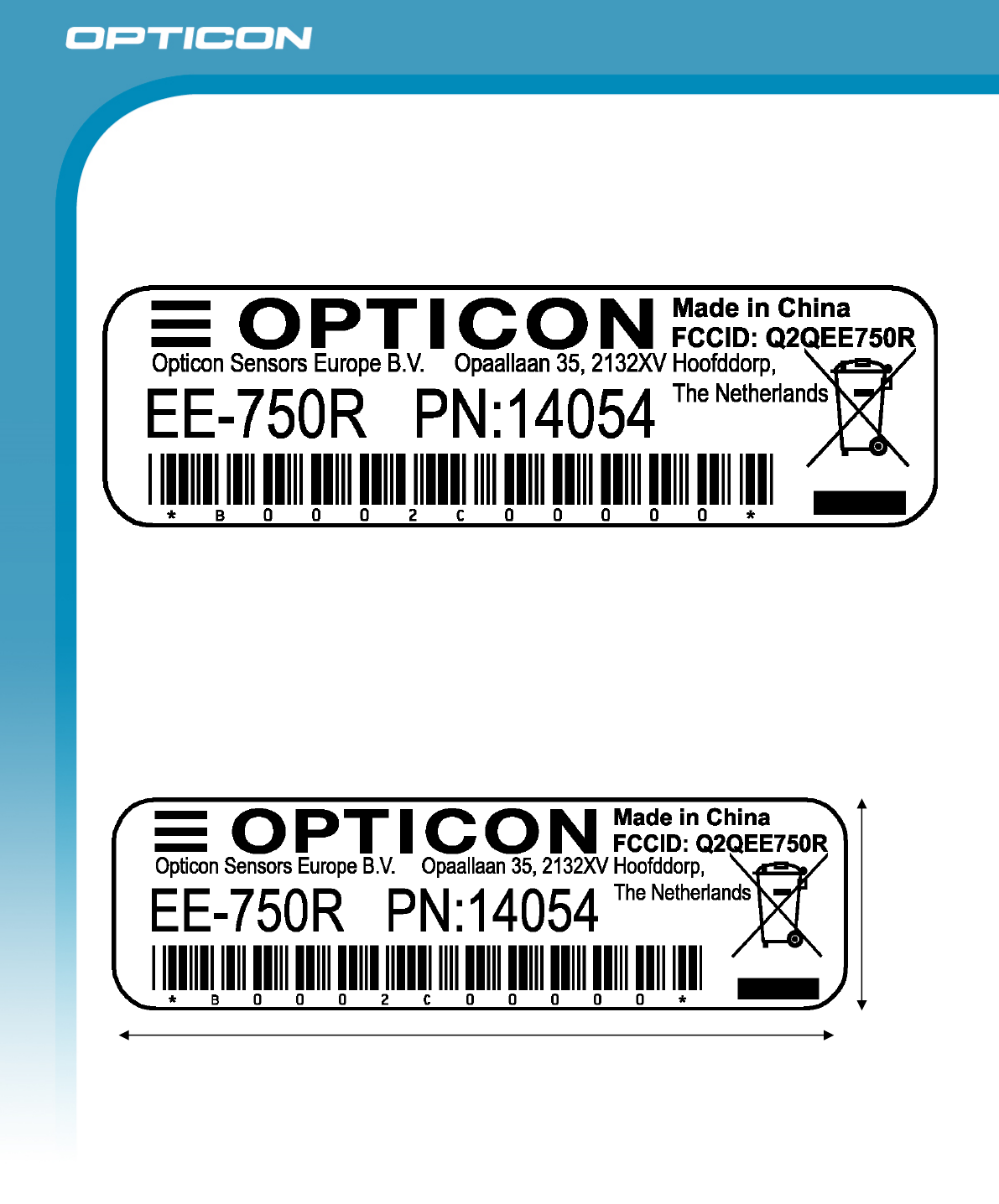
-
9
7. Labeling
7.1. Product label
The product label is affixed to the ESL as shown below.
The barcode shows the product serial number.
Bwed by 10 hexadecimal digits. These correspond to the MAC address of the unit.
Material: Base + laminate protection against wear.
Base: PP film, thickness 80µm, backing with glue.
Laminate: PET film, clear, thickness 50µm.
The dimensions of the product label are as follows:
Figure 2: product label
Figure 3: product label dimensions
35
10
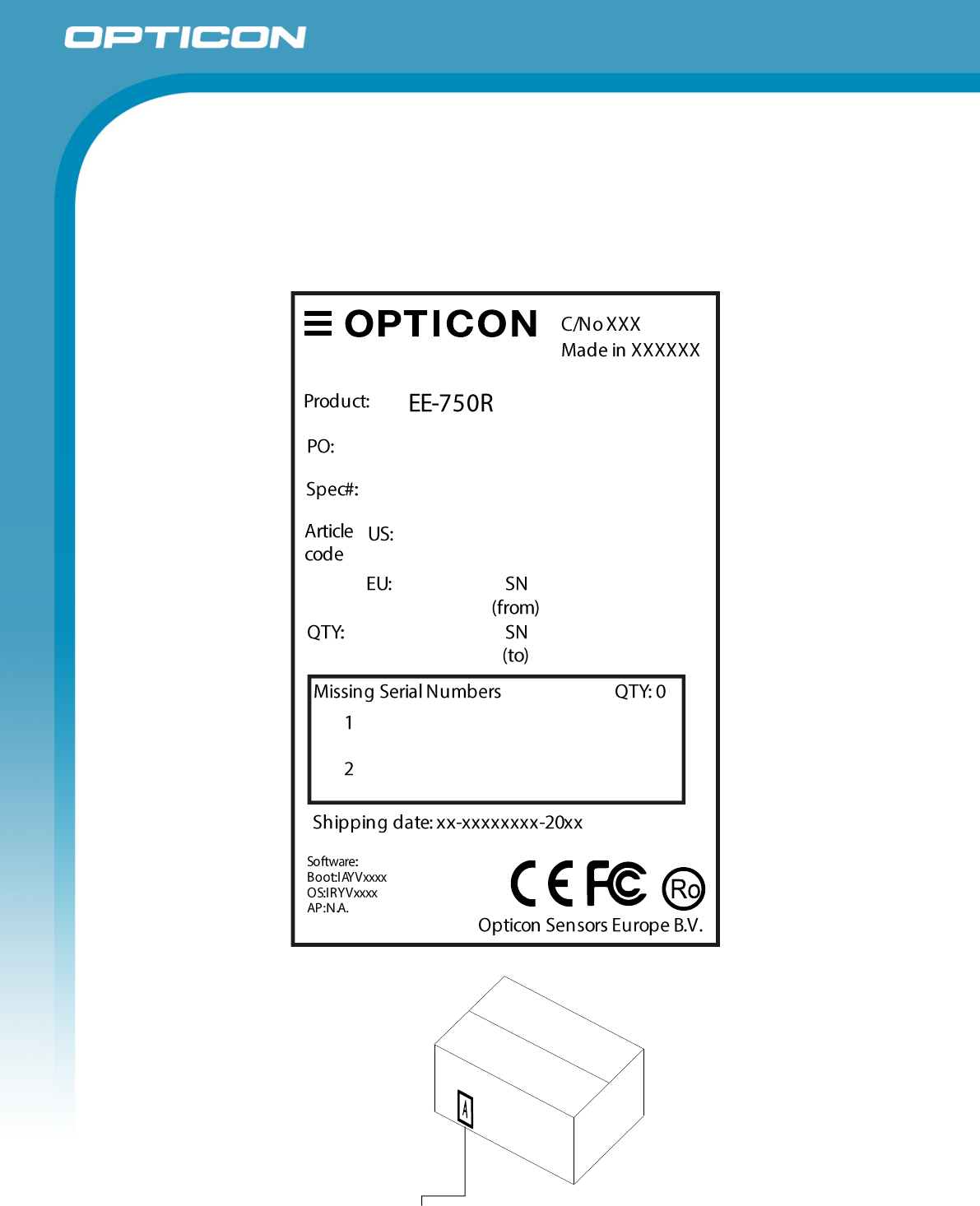
-
10
7.2. Shipment box label
The shipment box label is meant to show the number of labels in a box and their serial
numbers. Also information about the software versions and the order number is added.
The labels are 150mm*95mm and are made from plain paper with adhesive backing. For
more information, please check ShipmentBoxLabel_spec_rev1
Figure 4: shipment box label
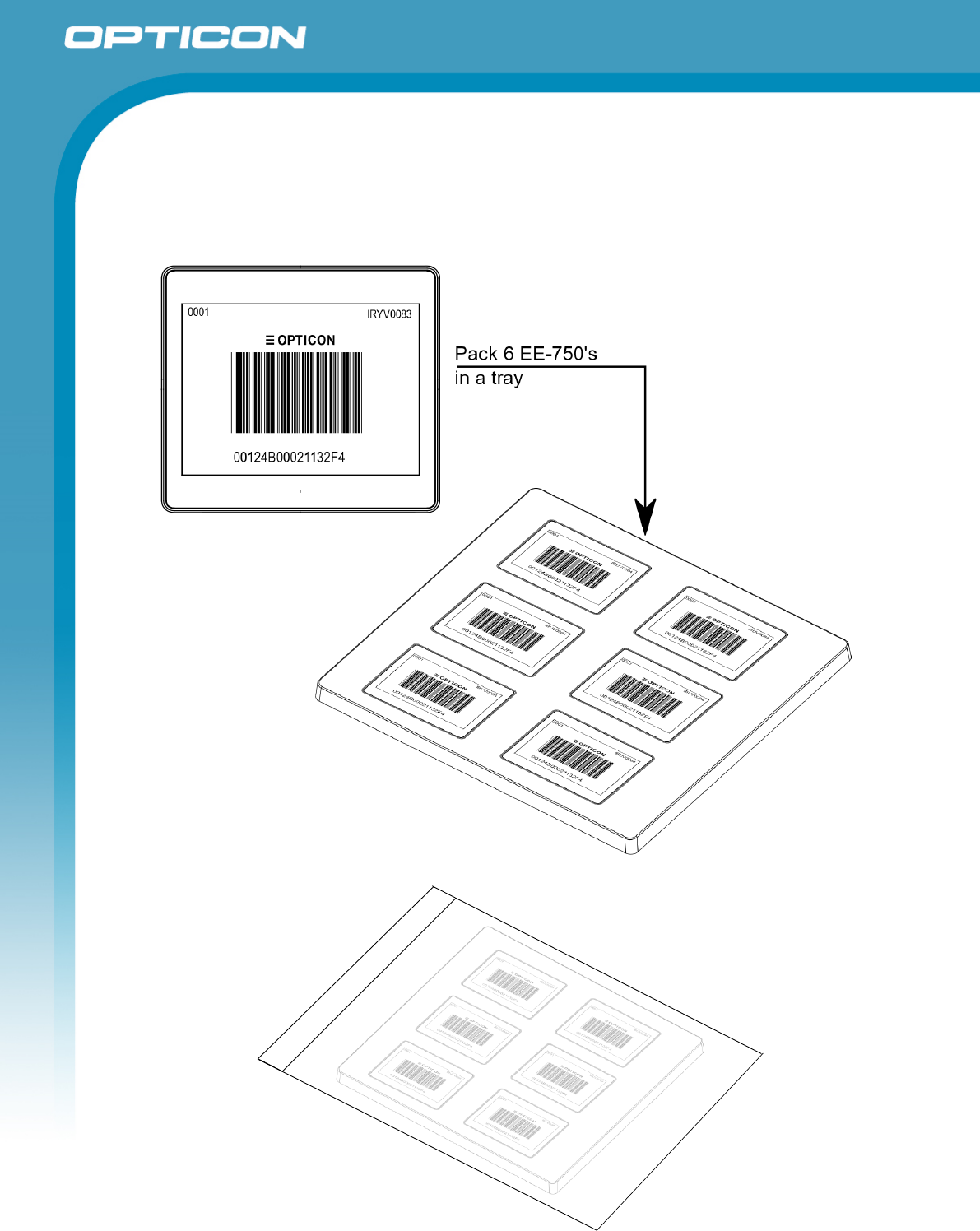
-
11
8. Accessories
Accessories, for instance for mounting, may be optionally available. Please contact Opticon for
information.
9. Packaging Specifications
Figure 5: Packing step 1: Put 6 pcs EE-750R in a plastic tray
Figure 6: Packing step 2: Add two bags of silica and put a bag around the tray
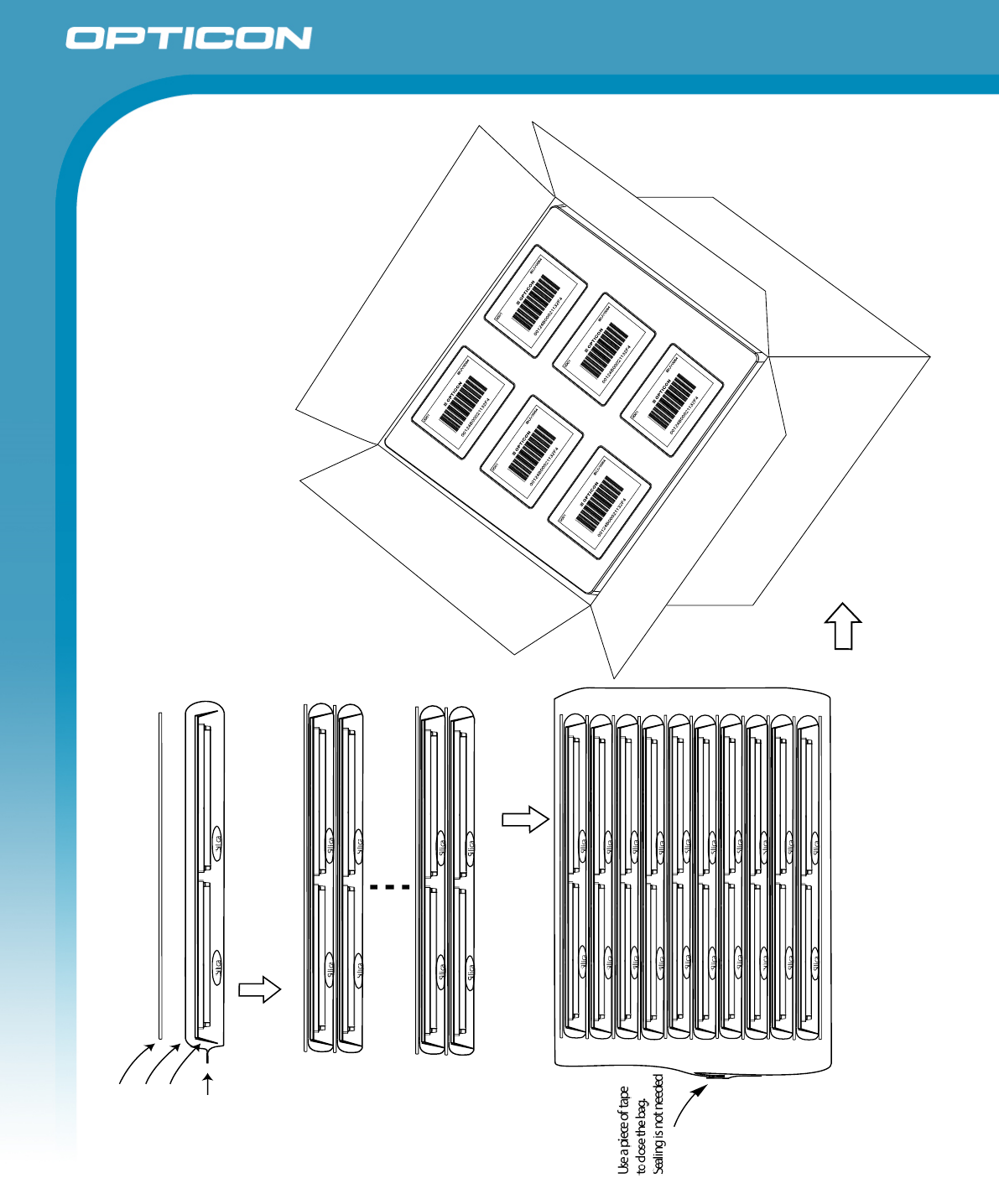
-
12
Figure 7: Packing step 3: Stack 10 trays (60 ESL’s) and put this into a shipping box
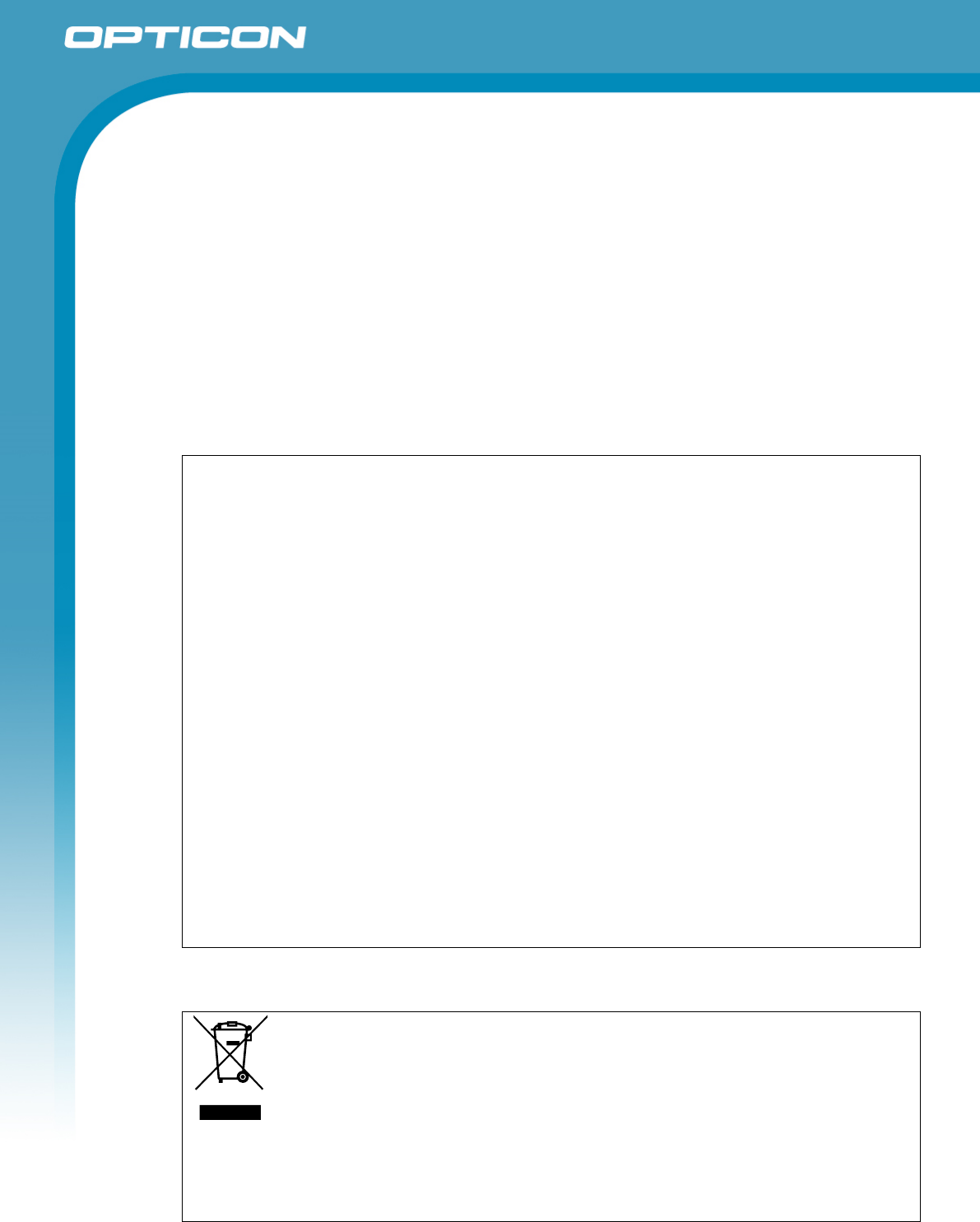
-
13
10. Regulatory Compliance
10.1. Product Safety
IEC 60950-1:2005 2nd +Am 1:2009 + Am 2:2013
10.2. EMC
EN 55032: 2015 + AC:2016-07
EN 55024: 2010 + A1:2015
RED Directive 2014/53/EU
EN 301 489-1 v2.2.0
EN 301 489 -17 v3.2.0
FCC Part 15 Subpart C Class B
Federal Communications Commission Notices
This product complies with Part 15 of the FCC Rules. Operation is subject to the following two conditions:
(1) this device may not cause harmful interference, and
(2) this device must accept any interference received, including interference that may cause undesired
operation.
Harmful Interference Notice
This product has been tested and complies with the specifications for a Class B digital device, pursuant to
Part 15 of the FCC Rules. These limits are designed to provide reasonable protection against harmful
interference in a residential installation. This equipment generates, uses, and can radiate radio frequency
energy and, if not installed and used according to the instructions, may cause harmful interference to radio
communications. However, there is no guarantee that interference will not occur in a particular installation. If
this equipment does cause harmful interference to radio or television reception, which is found by turning the
equipment off and on, the user is encouraged to try to correct the interference by one or more of the following
measures:
• Reorient or relocate the receiving antenna
• Increase the separation between the equipment or devices
• Connect the equipment to an outlet other than the receiver's
• Consult a dealer or an experienced radio/TV technician for assistance
Changes or modifications to this equipment that have not been approved by Ruckus Wireless may void the
user's authority to operate this equipment.
RF Exposure Information
This product complies with FCC radiation exposure limits set forth an uncontrolled environment.
10.3. WEEE
Waste of Electrical and Electronic Equipment Directive, 2012/19/EU.
The use of this symbol indicates that this product may not be treated as household waste. By ensuring this
product is disposed of correctly, you will help prevent potential negative consequences for the environment
and human health, which could otherwise be caused by inappropriate waste handling of this product. For
more detailed information about recycling of this product, please contact your local city office, your household
waste disposal service or the shop where you purchased this product.

-
14
10.4. RoHS
RoHS: The restriction of the use of certain hazardous substances in electrical and
electronic equipment, 2011/65 EC
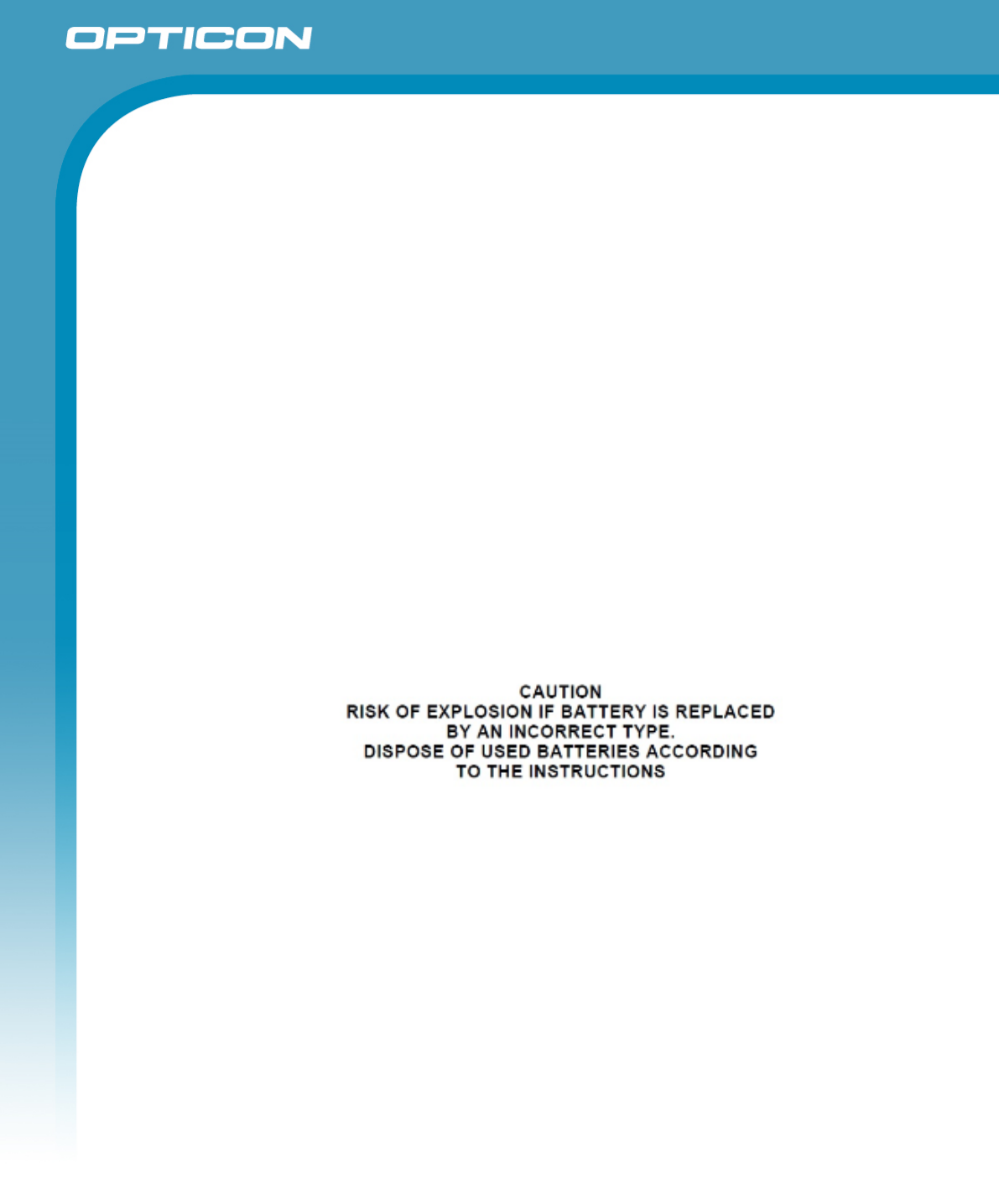
-
15
11. Safety
Handle this product carefully. Do not deliberately subject it to any of the following.
11.1. Shock
Do not throw or drop the ESL.
Do not place heavy objects on the ESL.
11.2. Temperature Conditions
Do not use the ESL at temperatures outside the specified range.
Do not pour boiling water on the ESL.
Do not throw the ESL into the fire.
Do not leave the ESL on the dashboard of a car.
11.3. Foreign Materials
Do not immerse the ESL in liquids.
Do not subject the ESL to chemicals.
11.4. Battery
Replace the battery when its lifetime has expired. The typical lifetime of a set of batteries
is 5 years when using quality alkaline batteries. Treat the batteries as chemical waste and
dispose of them according to local regulations.
11.5. Disposal
When discarding the product, treat it as chemical waste and dispose of it according to
local regulations.
11.6. Other
Do not disassemble this product, other than opening the battery compartment to
exchange the batteries.
The ESL may be damaged by high voltage discharges.
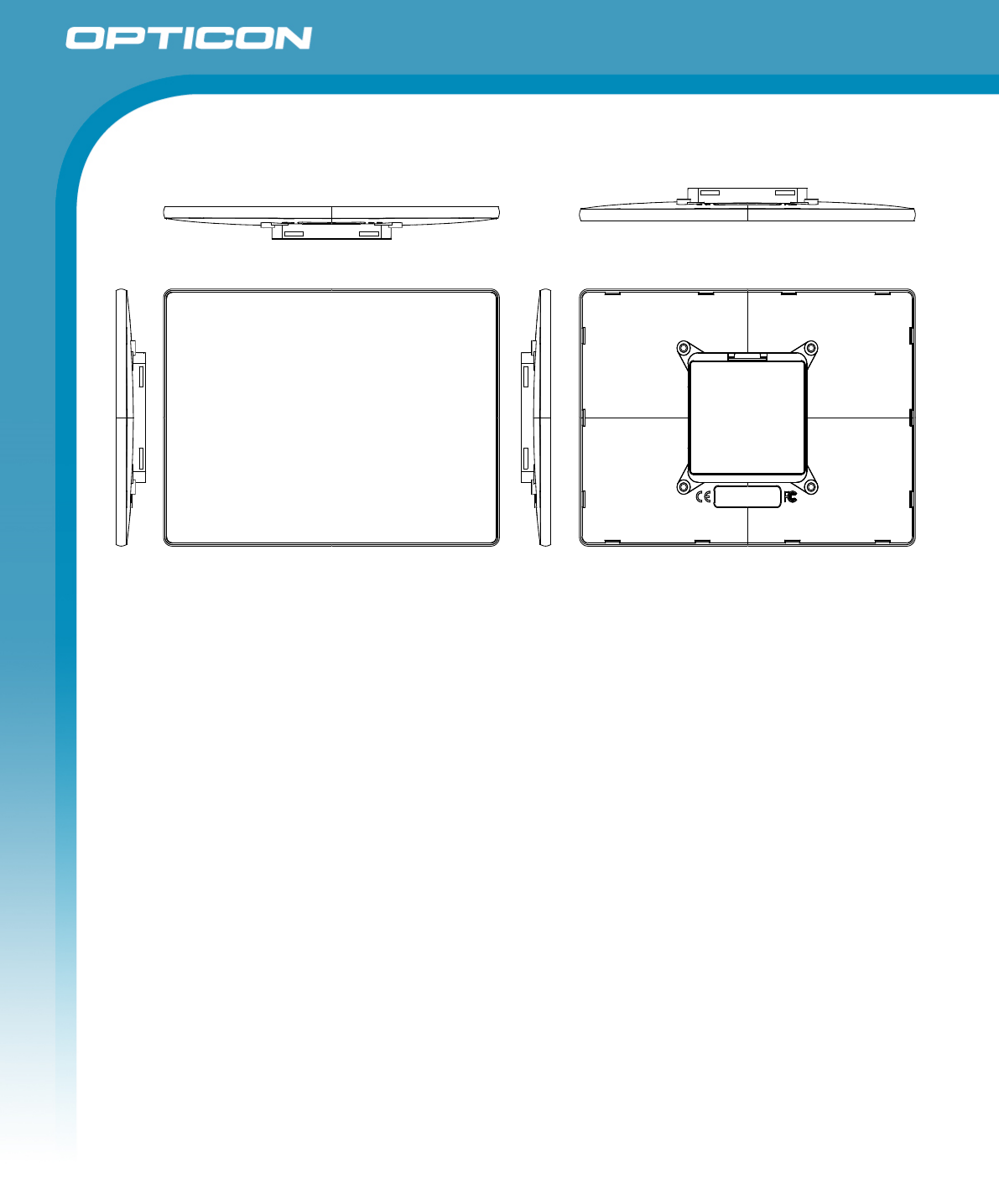
-
16
12. Mechanical Drawing
Figure 8: Mechanical drawing